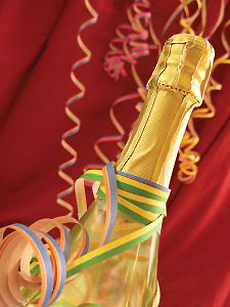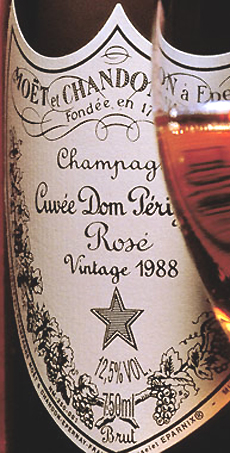
Call them bubblies, call them sparklers—they’re celebration wines. Photo by Kilián Zsuzsanna| IST.
|
R. VERONIQUE FITZGERALD is wine consultant and writer in New York City.
|
December 2007
Last Updated December 2011
|
 |
Product Reviews / Main Nibbles / Wine
Champagne & Sparkling Wine
Page 2: How To Buy Champagne
This is Page 2 of a five-page article. Click on the black links below to visit other pages.
How To Buy Champagne
The rule of thumb: If it’s imported from France and it says Champagne, it’s Champagne. Otherwise, it’s another type of sparkling wine. Champagne can only be made in Champagne region of France.
Champagne varies in sweetness. The sweetness of the dosage that is added before corking creates the level of sweetness (or dryness) of a Champagne. The word brut on the label means dry. Brut, Extra Brut and Brut Nature (little or no dosage) are the driest styles. Sweet Champagnes are hard to find, but they can be identified by the words Extra Sec (Extra Dry) Sec, Demi Sec and Doux. They go well not just with dessert, but with courses like foie gras that are traditionally paired with sweeter wines. By the same token, a very dry Champagne is not a good match for a sweet dessert. It would pair with anything a dry white wine would go with.
Champagne house styles vary. One house’s Brut can be another house’s Extra Dry. Each has its own blending recipes, so the best way to discover a style you like is to taste various brands.
- Vintage Champagne is usually more expensive than its nonvintage (NV) counterparts. Three great vintages currently on the market are the classic 1996 and the very good 1997 and 1998. Classic means it was a textbook vintage: All of the elements are in place and harmonious. If you can find it, 1990 was also a classic vintage. Krug 1990 is still around, usually for a mere $250.00.
- Rosé Champagne, the only rosé in France that can be made from blending red and white wines (other rosés are made strictly from red grapes whose skins are removed from the juice before all the color has infused), also tend to be more expensive and more full-bodied than their white counterparts. Don’t confuse these with “Pink Champagne,” which is not French and is colored pink, rather than allowing a natural color extraction from the grape skins.
|
|

Dom Pérignon Rosé Champagne, an exquisite treat.
|
- Blanc de Blanc Champagne is 100% Chardonnay. It tends to be very austere—lean and dry—because it is the blending of the Pinot Noir grape with the Pinot Chardonnay grape that contributes the fruitiness to Champagne.
- Blanc de Noir Champagne can be made exclusively from Pinot Noir, or a blend of Pinot Noir and Pinot Meunier. Blanc de Noir (“white of black”) is a white wine, sometimes with a very slight blush to it.
Continue To Page 3: Best Champagne
Go To The Article Index Above
Lifestyle Direct, Inc. All rights reserved. Images are the copyright of their respective owners.

|



